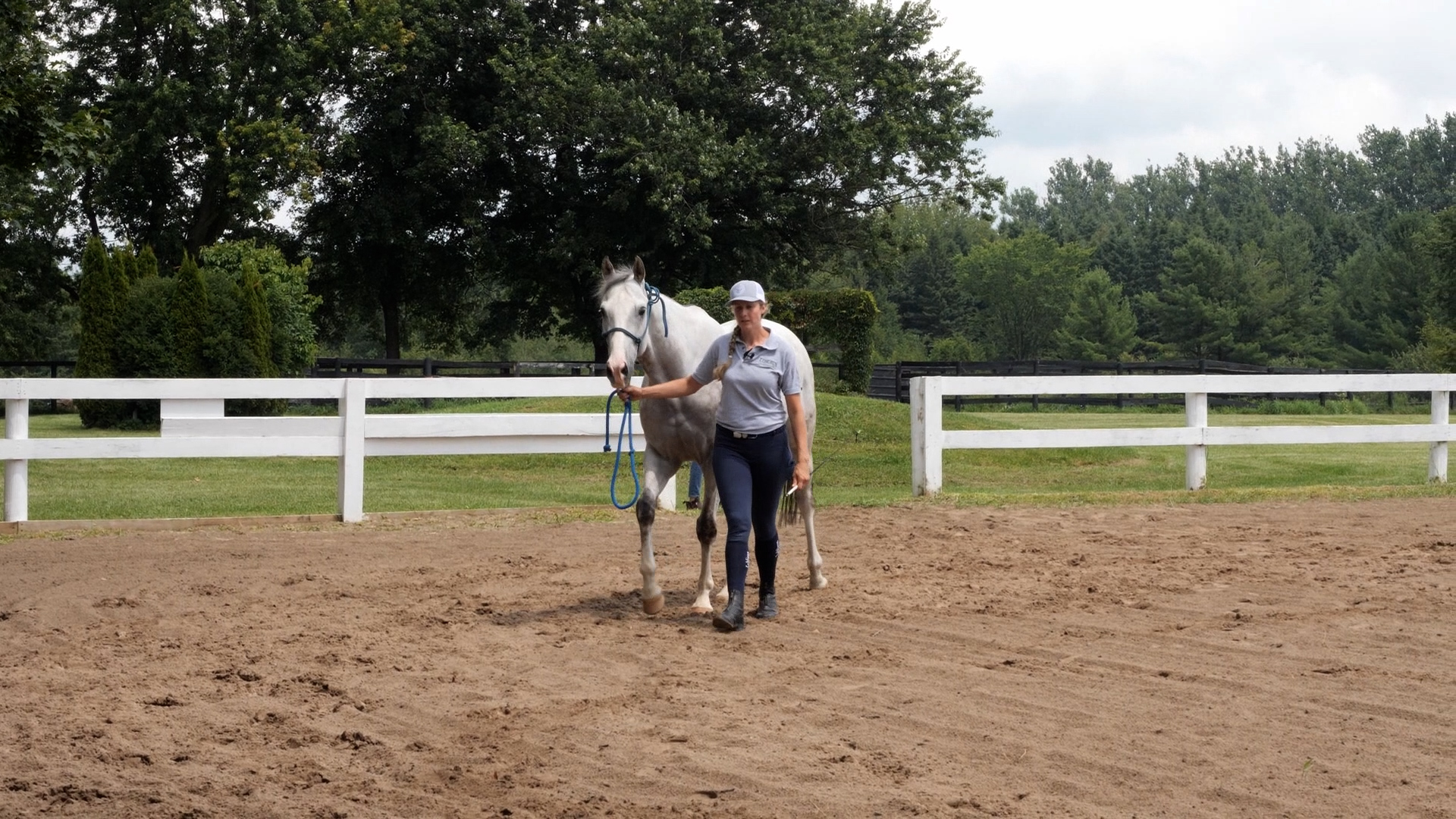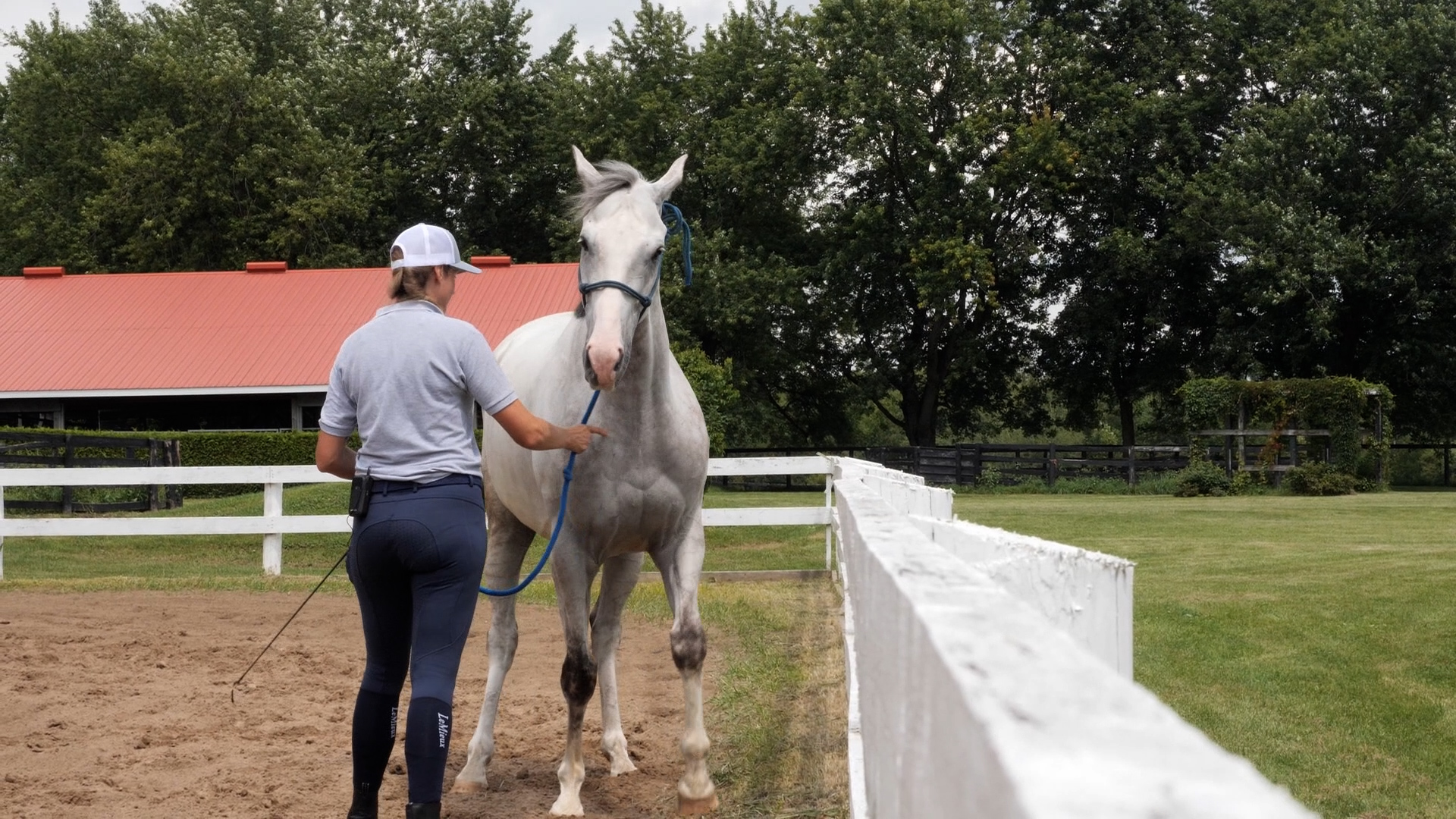More results...
Getting Started with Groundwork and Manners for Your Ex-Racehorse
Getting Started with Groundwork and Manners for Your Ex-Racehorse
By: Alexis Arbaugh

Lauren Millet, LongRun Thoroughbred Retirement Society
Thoroughbred Aftercare Alliance recently had the pleasure of speaking with Lauren Millet, the trainer at LongRun Thoroughbred Retirement Society, about her approach to retraining ex-racehorses. Based in Toronto, Canada, LongRun is a Thoroughbred Aftercare Alliance-accredited organization dedicated to the rehabilitation, retraining, and adoption of retired Thoroughbred racehorses. Growing up, Lauren frequented the racetracks in Canada and hoped that one day she would have a job working with racehorses. Years later, Lauren became the Farm Manager at LongRun, where she oversees the training and riding of all the horses that enter the facility. Her role involves assessing the training of each horse and building upon their foundation. Additionally, she evaluates each horse once the retraining process begins to determine the most suitable second career for them.
“Groundwork in racehorses totally varies based on where they come from, who their groom was and what they were allowed to do at the racetrack,” writes Lauren. Nearly all racehorses are hand-walked almost daily from the time they are weaned, which instills good manners and ensures they walk confidently and respectfully beside their handlers. However, Lauren notes that most ex-racehorses are not taught the following: “how to move away from pressure, back up when asked, step over or around obstacles, stand in crossties or tied outside.” The life of a racehorse is quite different from that of a sport horse, so they’re taught different skills from an early age to help them succeed in their specific careers. “They [racehorses] are taught the things that they need to know at the track, such as: how to tie in a stall, lead to the left, pick all 4 feet from the left side etc.,” Lauren says. She encourages people to recognize the importance of understanding what that specific horse was taught on the track, as it directly influences how they should be trained off the track.
At LongRun, horses arriving directly from the racetrack will either require rehabilitation with stall rest or benefit from a period of downtime before beginning their retraining program. “If a horse is on stall rest, obviously in-hand manners cannot be tested, but we do look for stall manners,” Lauren comments. Observing whether a horse respects your presence or shows signs of any bad behavior when you enter their space can be crucial in determining what to focus on during stall rest. It is the person’s job to show and teach the horse what you want from them. “With some it is easy, while others might be annoyed and irritated that they are on stall rest,” notes Lauren. She is essentially saying that there is a limited number of things that you can teach a horse while in a stall, but you can teach them to respect your space and to move away from pressure.
For horses that retire sound from the track and only need downtime, it’s easier to assess their groundwork and manners. Each horse will require a varying amount of downtime before beginning their retraining. Lauren feels that you can learn a great deal about a horse based on their behavior while walking to and from the pasture, “this gives us a chance to see which horses might require some ground to learn respect before jumping into the saddle and which horses might be good to go”. Teaching a horse to walk over poles, back up, and move away from pressure are essential skills for riding. Therefore, starting with groundwork—regardless of the horse’s prior training—provides them with a solid foundation and helps ensure the safety of both you and the horse. “It just helps to ease their confusion when learning all the new things at once,” Lauren expresses.
“Once they understand, it makes for a much happier time for both horse and human."

Once a horse has completed their rehabilitation or downtime, it’s time to focus on skills that will assist them in their second career. Lauren mentions that it usually becomes clear what kind of retraining a horse will need after they’ve been on the farm for a couple of days. Horses that arrive at LongRun with prior handling and riding experience typically transition more smoothly, as they already have a head start. In contrast, those with less experience require additional time to learn the basics before formal retraining can begin. “Many racehorses carry tension, and it’s important to teach them right away to let that go,” observes Lauren. She emphasizes the importance of ensuring that all horses are comfortable in their own bodies and able to move freely and without stress. Teaching a horse to remain relaxed and not feel tense can be challenging; it requires a significant amount of patience and understanding from the trainer, especially during the initial stages. “The goal is to teach the horse that whatever the encounter, their response should be to remain calm and think about what they are doing,” Lauren emphasizes.
Horses are intelligent and eager to please, but it’s essential to clearly demonstrate to the horse what behaviors are acceptable and which are not. “If you let them [horses] take an inch, they will take and mile,” writes Lauren. It’s important to kindly discipline a horse when they exhibit undesirable behavior and to praise them when they do something you approve of. A horse will remember the discipline and will be less likely to repeat the behavior that got them in trouble. Conversely, when a horse is praised for doing the right thing, they are likely to remember that positive reinforcement and want to replicate the behavior to receive more praise. Establishing clear ground rules from the beginning is vital, as it helps the horse understand your boundaries. “Once they understand, it makes for a much happier time for both horse and human,” Lauren remarks.
Some common issues with horses, aside from patience, include biting, kicking, pawing, and difficulty standing still. It’s easy to focus solely on disciplining these undesirable behaviors, but it’s important to consider the bigger picture. Is there an underlying issue causing the horse to lash out? Are you or someone else doing something that might make the horse uncomfortable? While biting and kicking are dangerous behaviors that must be addressed immediately, pawing and restlessness often stem from boredom. Lauren highlights the importance of teaching a horse patience and how to relax, “we really need to watch our horse and determine if they are trying to tell us something, or if a boundary needs to be set.”
A horse not only needs to respect us, but we must also learn to respect the horse. They deserve personal space and respect just as much as we do. “It’s important for both horse and rider to understand each other, respect each other, and work together in a partnership,” urges Lauren. Establishing good manners and boundaries for both parties fosters a “safe and harmonious” work environment and a successful pathway to a new career for a former racehorse.
Watch Our Video Series:
LIFE AFTER RACING
Transitioning Thoroughbreds Post Racing Career
Featuring LongRun Thoroughbred Retirement Society
About the series
Thoroughbred Aftercare Alliance’s blog series, “Retraining Tips,” aims to support adopters of Thoroughbreds retired from racing with the retraining process. Whether an individual has already adopted or is considering adoption, this series hopes to provide valuable guidance. Thoroughbred Aftercare Alliance has accredited 86 organizations, 63 of which specialize in retraining. Thoroughbred Aftercare Alliance has worked with some of these organizations’ in-house trainers and has compiled a list of the most common tips, advice, and challenges they see, along with instructions on how to work through and overcome them. Throughout the retraining series, Thoroughbred Aftercare Alliance hopes to be a trusted source of retraining information that adopters can use in their retraining process.






